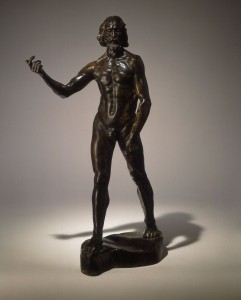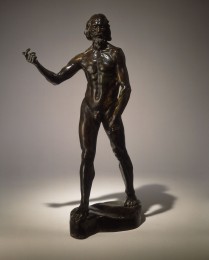
St. John the Baptist Preaching
In 1913 Rodin spoke of what happened when an Italian peasant from the Abruzzi region came to his studio to offer himself as a model:
As soon as I saw him, I was filled with admiration; this rough, hairy man expressed his violence in his bearing, his features and his physical strength, yet also the mystical character of his race. I immediately thought of a Saint John the Baptist, in other words, a man of nature, a visionary, a believer, a precursor who came to announce one greater than himself. The peasant undressed, climbed onto the revolving stand as if he had never posed before; he planted himself firmly on his feet, head up, torso straight, at the same time putting his weight on both legs, open like a compass. The movement was so right, so straightforward and so true that I cried: ‘But it’s a man walking!” I immediately resolved to model what I had seen…. That’s how I came to make The Walking Man and Saint John the Baptist, one after the other. All I did was copy the model that chance had sent me.
Saint John the Baptist was a popular subject at Rodin’s time. But other artists’ Saint Johns followed Biblical descriptions more closely than did Rodin’s; they were shown as children or roughly clothed adults, they carried the saint’s traditional attributes, and they gestured so as to bless or baptize Christ. Rodin’s Saint John was nude, carried no attributes, and his gesture was ambiguous. Still – or because of this – the piece was one of Rodin’s most popular. There was an active exhibition and sales market for casts in the original size (80 inches tall) and in three different reductions (31-32 inches, 19-20 inches and 8 inches). Critics wrote in admiration of the musculature of the figure’s back (and were not bothered that it did not complement the emaciated front of the ascetic’s body).
than did Rodin’s; they were shown as children or roughly clothed adults, they carried the saint’s traditional attributes, and they gestured so as to bless or baptize Christ. Rodin’s Saint John was nude, carried no attributes, and his gesture was ambiguous. Still – or because of this – the piece was one of Rodin’s most popular. There was an active exhibition and sales market for casts in the original size (80 inches tall) and in three different reductions (31-32 inches, 19-20 inches and 8 inches). Critics wrote in admiration of the musculature of the figure’s back (and were not bothered that it did not complement the emaciated front of the ascetic’s body).
In 1901 the critic Mauclair wrote:
Everyone today feels that the hand that modeled Saint John the Baptist and erected The Gates of Hell is the only one powerful enough, in Europe and in this century, to seize hold of sculpture in its entirety and pull it out of the rut into which it could easily have got bogged down.





No Comments